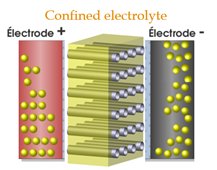Sous confinement nanométrique, les interactions complexes entre la topologie de confinement, la dimensionnalité (3D à 1D) et le rapport surface/volume affecte de manière significative les propriétés physiques des matériaux confinés.
Dans le domaine des nouvelles technologies pour l’énergie, on va bénéficier du confinement pour modifier drastiquement le comportement des électrolytes, à avoir la conduction protonique par confinement anisotrope 1D en présence de liquides ioniques. L’équipe confinement multi-échelle s’intéresse donc à la compréhension des phénomènes de transport dans les électrolytes (conductivité protonique, par des alcalins ou des alcalino-terreux), et en particulier les modifications qui peuvent être apportées par l’hétérogénéité locale, l’anisotropie ou les effets de confinement (1D, 2D, 3D). L’équipe confinement multi-échelle s’intéresse également aux polymères en solution et en fondu (transition vitreuse et glissement), aux liquides simples (auto-association et confinement nanométrique), à la conception de matériaux nanoporeux stimulables (nano-valves) et aux phénomènes d’élasticité de cisaillement à basse fréquence dans les polymères fondus ou des liquides simples et sur la relation entre l’écoulement et le temps de relaxation moléculaire.
A partir de la synthèse de matériaux nanoporeux hybrides à base d’oxydes métalliques (Alumine), de mésoporeux (MCM41) et de nanotubes de carbone, on va pouvoir étudier les effets de piégeage et de relargage des polluants organiques (antibiotiques, colorants, pesticides), ainsi que le confinement de biomolécules, de solutions aqueuses en présence de sels pour des applications pour le stockage d’hydrogène et la photo-catalyse. Sur des systèmes biomimétiques, on aborde la dynamique de peptides et de protéines en présence d’eau (poudres et solutions aqueuses), la structure de phases membranaires de phospholipides en présence d’ions, avec un intérêt potentiel en pharmacie et thérapie génique ainsi que la structure de l’eau surfondue.
Les processus dynamiques sous confinement vont être accessibles par les méthodes de diffusion inélastique des neutrons sur une large gamme de temps caractéristiques (de la ps à quelques centaines de ns). Ces processus sont complétés aux temps plus longs (ms) par des méthodes complémentaires de RMN, de spectroscopie diélectrique et de méthodes de microfluidiques et plus récemment par l’apport de la modélisation moléculaire pour extraire des informations telles que la nature des sphères de coordination et les temps de vie des espèces associées.









